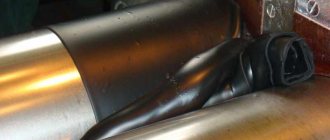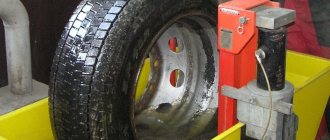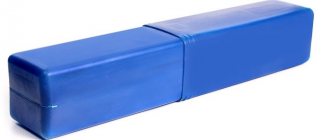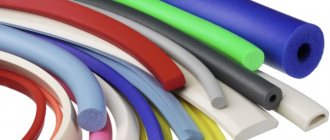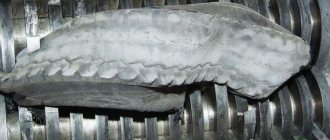Types of rubber
Rubber is one of the few materials that has different hardness. Depending on the percentage of sulfur, it is:
- soft – contains up to 3% sulfur;
- semi-solid – from 4 to 30% sulfur;
- hard – more than 30%.
Rubber is a natural material, and as a rule, products made from natural ingredients are of the highest quality and most durable. Therefore, components for bicycle and car wheels are made of soft rubber, which is based on rubber.
Electrical vulcanization of rubber
In general, vulcanization can be cold or hot. The electrical vulcanization process is a hot method. An electric stove with a ceramic heater is used as a heater at home; a hair dryer or a regular iron is also suitable. The optimal temperature for this method is 145С. To determine the temperature, you can also use available means, for example, if a sheet of paper begins to char, it means that the temperature has reached the required values.
Electrical vulcanization of rubber
There are also special clamps with a heating element. Such devices can operate from a 220V household network, from a car battery, through a cigarette lighter socket, or from their own battery. It all depends on the performance of each device. These clamps are easy to use; you need to attach a rubber patch to the camera, clamp it and plug it into the network.
Vulcanization process
The rubber vulcanization process can be divided into cold and hot. The first one can be divided into two types. The first involves the use of sulfur semichloride. The mechanism of vulcanization using this substance looks like this. A workpiece made of natural rubber is placed in the vapor of this substance (S2Cl2) or in its solution, made on the basis of some solvent. The solvent must meet two requirements:
- It should not react with sulfur semichloride.
- It should dissolve the rubber.
As a rule, carbon disulfide, gasoline and a number of others can be used as a solvent. The presence of sulfur semichloride in the liquid prevents the rubber from dissolving. The essence of this process is to saturate the rubber with this chemical.
Charles Goodyear invented the process of vulcanizing rubber
The duration of the vulcanization process with the participation of S2Cl2 ultimately determines the technical characteristics of the finished product, including elasticity and strength.
The vulcanization time in a 2% solution can be several seconds or minutes. If the process takes too long, so-called over-vulcanization may occur, that is, the workpieces lose their plasticity and become very brittle. Experience suggests that with a product thickness of about one millimeter, the vulcanization operation can be carried out in a few seconds.
This vulcanization technology is the optimal solution for processing parts with a thin wall - tubes, gloves, etc. But, in this case, it is necessary to strictly observe the processing modes; otherwise, the top layer of parts can be vulcanized more than the inner layers.
At the end of the vulcanization operation, the resulting parts must be washed with either water or an alkaline solution.
There is a second method of cold vulcanization. Rubber blanks with a thin wall are placed in an atmosphere saturated with SO2. After a certain time, the workpieces are moved into a chamber where H2S (hydrogen sulfide) is pumped. The holding time of workpieces in such chambers is 15 – 25 minutes. This time is sufficient to complete vulcanization. This technology is successfully used for processing glued seams, which gives them high strength.
Special rubbers are processed using synthetic resins; vulcanization using them is no different from that described above.
Hot vulcanization
Rubber, as a raw material, has the property of being welded into a single composition at a temperature of 150 °C. As a result of this process, the rubber becomes rubber and cannot return to its original position. Thanks to its capabilities, rubber can fix any punctures and cuts in the tube and tire.
It is necessary to vulcanize rubber using a hot method, only using a press. The depth and area of the cut will tell you how long to weld. Typically, it takes 4 minutes of cooking to repair a 1mm cut. Accordingly, if the cut is 4mm, then it needs to be vulcanized for 16 minutes. In this case, the equipment must be warmed up and configured.
By performing hot vulcanization at temperatures above 150°C, you can ruin the rubber and achieve nothing, since the material will deteriorate and lose its characteristics.
Using clamps or a press allows you to properly patch the damage. After finishing the work, you should make sure that there are no voids or air bubbles in the seam. If there are any, you need to clean the puncture site from fresh rubber and repeat the whole process again.
In order to hot seal a camera at home, you must do the following. From raw rubber, you need to cut a piece slightly smaller than the patch itself. The tube or tire is cleaned slightly wider at the damaged area, to a rough state, and then degreased with gasoline. When preparing the patch, you need to cut the chamfer at an angle of 45°, also sand and degrease. Then we cover the puncture site with a patch, clamp it in a vice and heat it to the desired temperature.
If you dissolve raw rubber in gasoline, you can get a special glue for rubber, the use of which improves the quality of the seam. Particular attention should be paid to temperature conditions. Vulcanization is carried out at a temperature of 140 - 150 ° C; if there is a smell of burnt rubber, it means the patch has overheated, and if it has not merged with the overall product, then it may not have reached the required temperature. To prevent rubber from sticking to metal, you need to place paper between them.
Technology and time of vulcanization of raw rubber
The vulcanization time for raw rubber is approximately 4 minutes per millimeter of thickness. In this case, 30 minutes are given to warm up the intermediate cushions. For example, professionals can repair a tire in a couple of hours. If we are talking about a truck tire, the repair time can take up to 4 hours. There are several stages of processing and gluing a cut:
- The space around the damage is cleaned with a milling cutter.
- The rubber crumb is blown off, and the damaged area is treated on both sides with a special compound.
- A patch of appropriate size is installed on the inside of the tire.
- The outside of the cut is filled with raw rubber, which is preheated for better plasticity.
- The rubber is pressed against the tire and leveled; it should protrude by 3-5 mm.
- A hot press is used to glue the damaged area.
On a note.
The press plates may stick to the rubber, so you can insert paper between them. If the unvulcanized rubber does not completely fill the funnel, then air will remain in it and gluing will be impossible. In this case, you will need to re-place the material in the damaged area and perform all the manipulations again.
Crude rubber vulcanization time: table
Cold vulcanization
Nowadays, using this method is not difficult, since you can purchase a repair kit in every auto or bicycle parts store. The contents of this set may vary, but each one contains patches and special glue.
Cold vulcanization of rubber
The repair procedure in this case is similar to the hot method. You also need to treat the damaged surface with an abrasive, remove rubber dust and degrease. After drying, apply glue to the camera and glue the patch. In this case, it is not the duration of the pressure that plays a role, but its strength. Therefore, it will not be enough to simply press down with a stone; more force is required.
Do-it-yourself hot vulcanization technology for tires
This technology is used a little longer than cold technology. At a time when there were not so many tire shops around, car and bicycle enthusiasts repaired their vehicles in the garage using exactly this method, which uses an electric or gasoline vulcanizer, which can be easily assembled with your own hands. The technology here is as follows: the master burns gasoline, which warms up the rubber using a piston. As soon as the temperature rises to 90 degrees, the raw rubber for vulcanization begins to strengthen; if you raise the temperature to 147 degrees, the process goes noticeably faster and with better quality. But it’s better not to raise it above 150, because... the material begins to deteriorate and loses its properties. After 160 degrees, raw rubber begins to char. The ideal warm-up time for hot vulcanization of raw rubber is about 8-10 minutes. A fragment of material is applied to the puncture site on the camera and compressed using a clamp so that during the chemical reaction bubbles do not form and air does not collect, forming dangerous voids.
In field conditions, it is much more difficult to carry out such an operation for cameras, but it is still possible: if there is a piece of raw rubber, you can heat it over a fire. You can determine the temperature of the flame by looking at a piece of sugar or a piece of paper: both begin to melt/char at a temperature of 145 degrees – exactly what is required for vulcanization. You can use a flat heavy stone, a wooden log or any other suitable object as a clamp.
The entire operation will take you about 20 minutes. Do not forget that the area where the inner tube patch is glued must be cleaned with sandpaper or at least wiped with gasoline to remove dirt from the tire.
Making a vulcanization device
Each vulcanizer has two main elements - a heating part and a clamping device. The basis of such rubber processing equipment can be used:
- iron;
- “bazaar” electric stove;
- piston from the engine.
In a device with an iron, the heating part is the surface that is used for ironing in everyday life. If we plan to use an electric stove, then the heating coil should be covered with a metal sheet, and when working, you need to place paper between the rubber and the metal. Such a device must be equipped with a thermostat to avoid overheating of the material.
The pressing part of the vulcanizer is easiest to make from a clamp. The simplest device to manufacture would be a device consisting of an iron and a clamp. Since they are both metal, joining them using arc welding is not difficult. The iron also has a thermostat.
A piston vulcanizer also uses a metal plate. A rubber bladder is placed on it. The piston, with its smooth part, which is in contact with the explosive mixture in the engine, presses down the patch using a homemade clamp. Paper is also placed between the piston and the patch. After that, gasoline is poured into the piston and ignited.
Such a device made from a piston is especially useful on the road, when there is no way to connect to the electrical network. However, such a device does not have a thermostat, and the temperature will have to be controlled manually.
DIY tire vulcanizer
Any vulcanizer must consist of a press and a heating element.
You can even do it with your own hands, with ingenuity and skillful hands. You can make a unit:
- from a household iron;
- from an electric stove;
- from a piston from a car engine.
If you use an iron, its sole will serve as a heating element. A device with a thermostat would be ideal. A pipe can act as a press. Such a vulcanizing device will require a minimum investment of money and material.
Pay attention! If you use an electric stove, then in this case you will need to put a metal plate on the spiral. Before laying rubber on it, it is recommended to put paper on it so that the plate does not stick. You will also need to attach a thermostat here, which is set to turn off at 150°. Here you can also use a pipe cutter as a press.
A piston vulcanizer will become an indispensable assistant if a tire puncture occurs on the road, and there are no special materials for vulcanization and a socket at hand. This unit works according to the following scheme:
- The camera is placed on a flat metal surface.
- The damaged area is pressed against the bottom of the piston and firmly fixed.
- Paper is placed between the rubber and metal.
- Sand is scattered next to the piston (so that the paper does not burn).
- Gasoline is poured into the piston and ignited.
In this way, it is possible to carry out vulcanization using practically improvised means.
Homemade vulcanizer
It is quite possible to carry out homemade vulcanization, but it is better if this work is done by professionals at a service station. This procedure does not take much time and is inexpensive.
Pros and cons of vulcanization
The main advantage of the tire repair process is that it is cheaper to repair than to buy a new one. However, each situation is individual, so it is important to determine whether repairs will save the situation.
The cold method is quite easy to use, it will not take much time, and the costs will be minimal. The main disadvantage of this method is the unreliability of gluing. This procedure is temporary, and you should contact a service station as soon as possible.
Hot vulcanization reliably welds rubber, allows such work to be carried out at any temperature and has a low cost.
So, you can repair a tube or tire in different ways, but it is better to entrust this work to specialists, because it is for your own safety.
